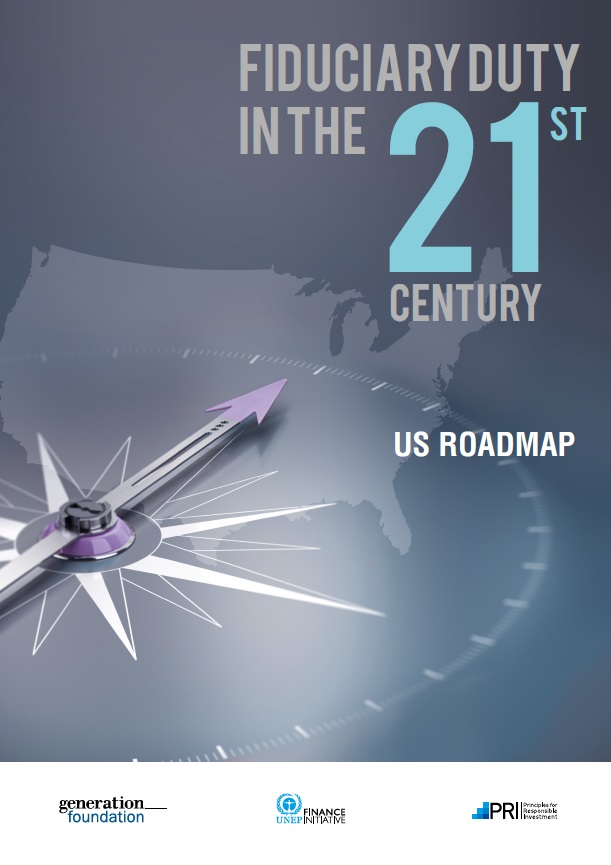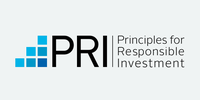Fiduciary duty in the 21st Century - US Roadmap
THE PROJECT
In January 2016, the Principles for Responsible Investment (PRI), the United Nations Environment Program Finance Initiative (UNEP FI) and The Generation Foundation launched a three-year project to clarify investors’ obligations and duties in relation to the integration of environmental, social and governance (ESG) factors in investment practice and decision-making. This follows the publication in September 2015 of Fiduciary Duty in the 21st Century by the PRI, UNEP FI, UNEP Inquiry and UN Global Compact.
Fiduciary Duty in the 21st Century concluded that fiduciary duty requires investors to consider long-term value drivers in the prudent practice of fiduciary investors. ESG factors are a core part of such an assessment and should be integrated into investment decision-making processes, engagement with investee companies and interventions in public policy and regulation.
The project has three components:
• Working with investors, governments and intergovernmental organizations to develop and publish an international statement on investors’ obligations and duties.
• Publishing roadmaps on the policy changes required to achieve full integration of ESG factors in investment practices across eight countries (US, Canada, Germany, UK, Japan, Australia, South Africa and Brazil).
• Extending research into fiduciary duties to major Asian markets: China (including Hong Kong), India, Korea, Malaysia and Singapore. ESG integration is defined as the systematic and explicit inclusion of material ESG factors into investment analysis and investment decisions.
INTRODUCTION
This roadmap enables the PRI and UNEP FI to work with investors, stakeholders and policymakers in the US to ensure that regulatory frameworks reflect the modern interpretation of fiduciary duty. This interpretation requires investors to consider long-term value mdrivers, of which ESG factors are a core component, in investment processes and decision-making.
STAKEHOLDER FEEDBACK
This roadmap draws on over 30 interviews with stakeholders at different points in the US capital market. There were common themes in the feedback provided by stakeholders. These have formed the basis for the analysis and recommendations that follow and are summarized below.
Stakeholders noted that the proportion of assets under management in the US subject to ESG integration was growing rapidly. Investors were increasingly seeing the value to ESG analysis and were responding to a rising tide of client demand for ESG services. Several major US investors had become signatories to the Principles for Responsible Investment with many more seeking to join or enquiring about the principles. It was suggested that there remained misconceptions and knowledge gaps regarding ESG integration in the US. These could be a source of scepticism and hold back its acceptance as a mainstream investment practice in parts of the US capital market. Stakeholders also sought to emphasize that ESG integration takes time to implement. It is a process and requires senior institutional support and education. In that context, it was noted that ESG integration methods were a subject of renewed focus for many investors and their industry organizations. Even where there was scepticism, there was growing interest.
Our stakeholders sought to make ESG integration an operational reality, rather than being perceived as an addition to an investor’s compliance burden. This required two broad developments.
Firstly, the reporting of comparable, decision-relevant ESG information by corporations. Secondly, the incorporation of ESG factors and performance assessments into organizational processes and also arrangements with intermediaries, such as investment consultants and fund managers. It was broadly acknowledged that prudent investment practices were a function of sound and accountable governance structures.
In the context of increasing reliance on low-cost, passive investment strategies, stakeholders noted the importance of engagement as a core element of prudent investment practice and the mindful use of shareholder rights, such as proxy votes. Stakeholders wanted to see the quality and resourcing of engagement practices become a source of competitive differentiation between investment managers.
Litigation risk was identified as a key obstacle for schemes considering adjusting investment practices. Fiduciaries sought legal clarification of their discretion to integrate ESG and were concerned to avoid initiatives that might elevate scheme costs.
Stakeholders further indicated that changes in underlying statutes were not required as they provided flexibility for ESG factors to be taken into account. Several stakeholders were also concerned that seeking legislative change to make explicit reference to ESG considerations could take us “down the legal rabbit-hole”; distracting from a focus on prudent investment practice. Stakeholders were also generally resistant to expansions in regulatory remit. They noted that relying on regulatory guidance can be vulnerable to political considerations in a way that broad, market-practice-based assumptions about investment activity are not. That analysis was counter-balanced by several stakeholders that identified well-framed regulatory guidance as a catalyst for plan fiduciaries to revisit governance structures and investment processes.
In developing this document, we have sought a balance between regulatory action and investment processes. We have sought to engage with the broad trends in the US capital market. We set out a series of recommendations.
SUMMARY RECOMMENDATIONS
• Overcoming misconceptions and knowledge-gaps on ESG integration
• Update Reg S-K to ensure high quality disclosure of material mESG information
• Guidance to trustees and plan sponsors on investment mconsultant services
• Updated legal guidance regarding fiduciary duty
• Enhanced framework for shareholder engagement with investee companies
• Revision of Investment Policy Statements
• Disclosure of investment practices
• Diversified governance structures
• Improved Stock Exchange guidance on ESG disclosures
To download the full study,please click here.

